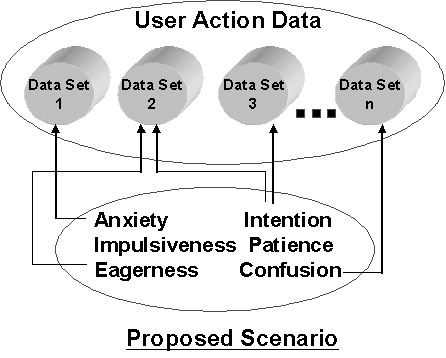
Study of User Behavior on the World Wide Web
Abhijit Rao
Manipal Institute of technology
Department of Computer Engineering
Manipal 576119
India
Title of the study
Study of User Behavior on the World Wide Web
Introduction
World Wide Web has a mammoth user base. Till now, very little efforts have been taken to bridge a relation between the possible user behavior and the analysis done on user data. User behavior analysis over the WWW is not just collection and scrutiny of web data collected from the Log files but is much more sophisticated. A need for simplification of this sophistication has lead to the inception of this research study.
Statement of the problem
This research study proposes to relate various possible emotions developed during the use of resources on the WWW with that of data collected from userís physical actions. Particular sets of data can be associated with one or more emotional attribute. If we can detect and grade such data sets we can certainly gain a deeper insight into the userís online[1] behavior.
Review of Previous Work
Tremendous amount of work has already been done when it comes to perceiving the userís navigation pattern. Little effort has gone in linking the navigation pattern with that of userís frame of mind. Since every activity has equal contribution from the brain and the body we need to discern the mental status of the user. According to Pirolli and Card[2], Information Foraging Theory is an approach to understanding how strategies and technologies for information seeking, gathering, and consumption are adapted to the flux of information in the environment. Humans actively seek, gather, share, and consume information and this activity depends on the user emotional level. This study too doesnít talk much about how we can achieve user data and draw its connection to the user actions. The fundamentals are well distinguished but we are unaware of what data values correspond to what level of information consumption.
Scope of Study
The scope of the study is to provide vital information that will form basis for any future research which involves identification of user behavior on the World Wide Web. The outcome of this study will be such that the empirical results can be cited in most efforts related to user online behavior.
Objective of Study
The prime objective of this study is to identify and differentiate between various behaviors expressed by a user in the form of physical gestures which are registered in the online environment. A unique alliance shall be drawn between the user behavior attributes and collected user data.
Study Details
The advent of World Wide Web put forth a plethora of challenges. One of the challenges is to recognize a user in terms of his digital behavior. Digital behavior is different from real-life behavior as it includes several issues in addition to the userís mental behavior. These issues involve varying levels of skills, challenges, flow on the user-end and peripheral movements and actions, network connectivity and browsing environment on the technical-end. So the study here will be to first understand the various elements of user behavior. The primary classification of user behavior can be made as: user navigational behavior and user psychological behavior. User navigational behavior may be slightly more easily accomplished. Whereas, user psychological behavior is more convoluted. The best methodology to analyze user psychological behavior will be to study various individuals with diverse attitudes when online.
The focus of the research study will be on users and variety of behavior projected by them when in an online environment. Till now, very little efforts are taken to bridge a relation between the possible emotions and the analysis done on user web data. For example, it can be discerned that an emotional behavior of boredom could be segregated from relaxed actions. The challenge of this study will be to explicitly state a specific type(s) of user behavior when digital actions are registered. The illustration expresses the ideology with greater clarity.



This study will hold enormous significance in various applications of the World Wide Web. Todayís applications need some form of comprehensive analysis of user behavior in order to bolster their services.
Hypotheses Testing
Since this study involves a combination of psychology and computers, construction of an agent to register user actions and conclude userís emotional attribute is imperative in this study. So we plan to make use of Human Inspector and a Computer Agent who shall note the sampleís navigational and psychological characteristics in real-time. Once the sample completes his/her session a questionnaire followed by a personal interview shall be the job of the Human Inspector. During the personal interview questions like -Did you feel anxious? Did you lose your patience during the online session? - will help inspector gather the emotional attribute. A psychologist may even be referred to in order to distinguish between shades of emotions. The computer Agent shall record the user behavior and finally an association shall be drawn between the data sets and its pertaining emotional characteristic.
Reference period
This research study is planned to be accomplished in 8 months time.
Sampling
Samples will be taken from various age groups and varied academic/non-academic background. Since human behaviors are independent of ethical and economical settings we shall concentrate more on samples of different age groups. Most of the samples will be evaluated at the investigators institution of study.
Time schedule
|
Approximate length of research study |
8 months/32 weeks |
|
Preparing Theoretical Background |
14 weeks |
|
Data Gathering/Data Collection |
9 weeks |
|
Processing the data |
2 weeks |
|
Writing the report |
6 weeks |
|
Submitting the thesis |
1 week |